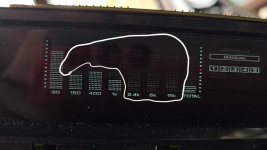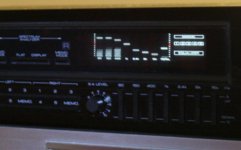What exactly makes the display "dirty"?the displays are disturbed by a dirty signal as you see in the attach video...
Your browser is not able to display this video.
If you do not know then why are you posting labels/judgements?I don't know, ...
@madis64 @jan.didden @as_audio As you can see in the first picture, even the non-involved bands are slightly illuminated, like a ghost effect. In fact, only the bands/frequencies produced should light up, not all of them.

In the second picture (i take it online), there's an example of what it should look like, the frequencies/band not involved are totally black, there's no "ghost" effect


In the second picture (i take it online), there's an example of what it should look like, the frequencies/band not involved are totally black, there's no "ghost" effect

Last edited by a moderator:
"should" is what you think.what it should look like,
You should compare the display to the measurment of the input signal - only after that you can draw any conclusions.
That noise may be generated inside the GE or it may be fed to it - your display would not know the difference (and there is always a possiblity that the display controller is generating the noise itself).
And yes, I do own a GE and have spent some time taking its measurements - but that was a lot of years ago...
No, because it's never done it before, just a few days ago."should" is what you think.
So you should think what has changed during the past days.because it's never done it before,
There is always a possibility that the device has developed a crack in the signal path but usually things like this boil down to bad contacts in the interconnects or RCA sockets breaking loose from the board.
I saw this ghosting occasionally.
You will need the schematic and my best bet is caps in the power supply line of the display.
@Mooly is by far the best expert (not only) on displays.
Hugo
You will need the schematic and my best bet is caps in the power supply line of the display.
@Mooly is by far the best expert (not only) on displays.
Hugo
If the op means this which can be seen at any point if the video is paused then I would guess it is possibly leakage internally in the VFD (the display tube). It is just possible it could be supply related but I'm doubtful on that.
Are both displays behaving the same as it seems to have two identical VFD's?
We used to see this kind of thing a lot on VCR displays where other characters would faintly illuminate in response to others being lit.
You should check the supplies to the display tube. Worth looking at this cap. The opto isolated triac is an oddity and I assume used for display dimming. I've never seen those used in a low voltage setting before.


Are both displays behaving the same as it seems to have two identical VFD's?
We used to see this kind of thing a lot on VCR displays where other characters would faintly illuminate in response to others being lit.
You should check the supplies to the display tube. Worth looking at this cap. The opto isolated triac is an oddity and I assume used for display dimming. I've never seen those used in a low voltage setting before.
Yes, both display have the same problemAre both displays behaving the same as it seems to have two identical VFD's?
Oh, so I try to change this oddity and I let you know. ThanksThe opto isolated triac is an oddity and I assume used for display dimming.
If the display supply is broken, how can that influence what is displayed, instead of things like contrast or brilliance?
It seems to me that the place to look is the element drive system.
Jan
It seems to me that the place to look is the element drive system.
Jan
- Home
- Amplifiers
- Solid State
- Kenwood GE-87 disturbed signal on display
